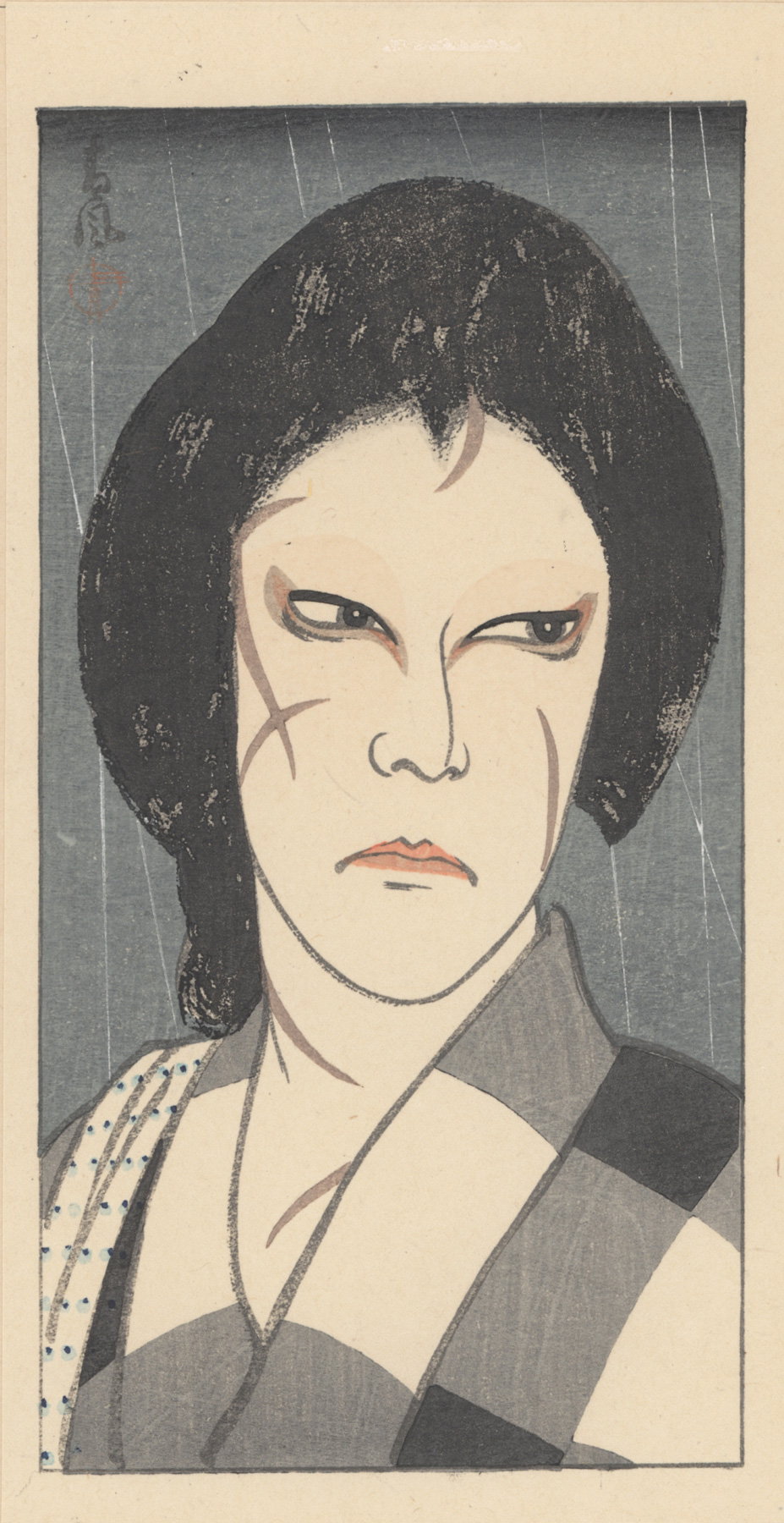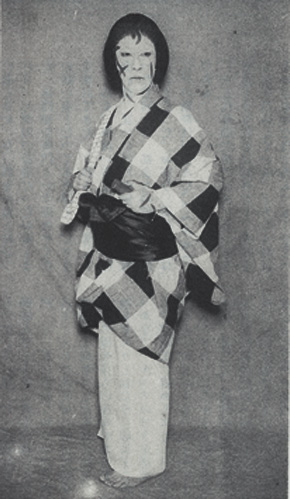About This Print
One of fourteen prints by the artist that appeared in the magazine Shin Nigao whose purpose was to advertise the Kabuki theater and renew interest in actor prints. This print which appeared in issue 3 of the mamgazine, published in August 1915, pictures the actor Sawamura Gennosuke IV 澤村源之助 (1859-1936) as Otomi in the play Kirare Otomi (Scarface Otomi).
For more information on this short-lived magazine whose purpose was to advertise the Kabuki theater and renew interest in actor prints, see the article Shin Nigao Magazine.
For more information on this short-lived magazine whose purpose was to advertise the Kabuki theater and renew interest in actor prints, see the article Shin Nigao Magazine.
The Actor in this Print
The Play
Source: "From Madonna to Femme Fatale. Gender Play in Modern Japanese Painting”, appearing in: Performing 'Nation': Gender and Sexuality in Literature, Theatre and the Visual Arts of China and Japan, 1880-1940, Doris Croissant, et. al., Brill, 2008, p. 283, 286.
Kirare Otomi (also called Musume gonomi ukina no yokigushi), written in 1864 by Kawakami Mokuami (1816-1893) was derived1 from the play Kirare Yosa first staged in 1853. Mokuami's 1864 version replaces the male hero with the female hero Otomi. In the Mokuami version Otomi, the mistress of a brothel proprietor, falls victim to her patron's jealousy and the patron sets out to end her love affair with Yosa by mutilating her with knife cuts all over her face. Otomi and her lover try to commit suicide, but are rescued. Bereft of her beauty and her lover, Otomi marries "Bat Yasu" (Kōmori no Yasu), a former servant of her patron. She meets Yosa again after years of separation, but now being a disfigured and aged woman, she takes revenge upon her patron by blackmailing him and extorting money, and moreover, kills her greedy husband, Yasu, so that her former lover is able to redeem his heirloom sword.Samuel Leiter writes, "The play reflects the decline of Japan during the late Edo era as the Tokugawa regime began to fall apart. Its action stresses scenes of torture, murder, and extortion. It also brings the role type of the 'rough woman' (akuba) vividly to life."2
1 In Kabuki there was a method called Kakikae in which the names of characters and part of the story development were rewritten, while leaving intact the main framework of a popular previous work. [Source: Japan Arts Council http://www2.ntj.jac.go.jp/unesco/kabuki/en/5/5_01.html
1 In Kabuki there was a method called Kakikae in which the names of characters and part of the story development were rewritten, while leaving intact the main framework of a popular previous work. [Source: Japan Arts Council http://www2.ntj.jac.go.jp/unesco/kabuki/en/5/5_01.html
2 Kabuki Encyclopedia, An English-Language Adaption of Kabuki Jiten, Samuel L. Leiter, Greenwood Press, 1979, p. 250.
Print Details
last revision:
Print Details
| IHL Catalog | #1319 |
| Title/Description | [Sawamura] Gennosuke [IV] as Otomi [in the play Kirare Otomi (Scarface Otomi)] 澤村 源之助 切られ お富 As titled on magazine page:  お富 源之助 [Otomi, Gennosuke] |
| Series | Magazine: Shin Nigao (New Portraits) volume 3 新似顔 第一年参編 |
| Artist | Matsuda Seifū (1880-1978) |
| Signature |  |
| Seal | Artist's 青 "Ao" seal (as shown above) |
| Date | August 1915 |
| Edition | First and only edition printed in magazine Shin Nigao |
| Publisher | Nigaodō 似顔洞 |
| Carver and Printer | Igami Bonkotsu (1875-1933) |
| Impression | excellent |
| Colors | excellent |
| Condition | excellent - slight overall toning |
| Miscellaneous | attached to original magazine page |
| Genre | shin hanga (new prints) nigao-e |
| Format | koban |
| H x W Paper | print size: 7 5/16 x 3 13/16 in. (18.6 x 9.7 cm) page size: 9 11/16 x 7 1/8 in. (24.6 x 18.1 cm) |
| Collections This Print | The British Museum 1991,1112,0.193.3 (entire magazine, only front cover shown); Art Research Center Ritsumeikan University BM-SJ193-03 (British Museum's copy of entire magazine with all pages shown) |
| Reference Literature |
7/28/2020



